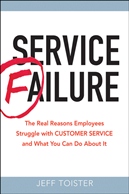A little bathroom humor
 Jeff Toister
Jeff Toister  Wednesday, November 17, 2010 at 10:10AM |
Wednesday, November 17, 2010 at 10:10AM | Over the past year I've collected a few interesting pictures of signs in (or near) restrooms. They all made me stop and ask, "What are they trying to tell their customers?"



